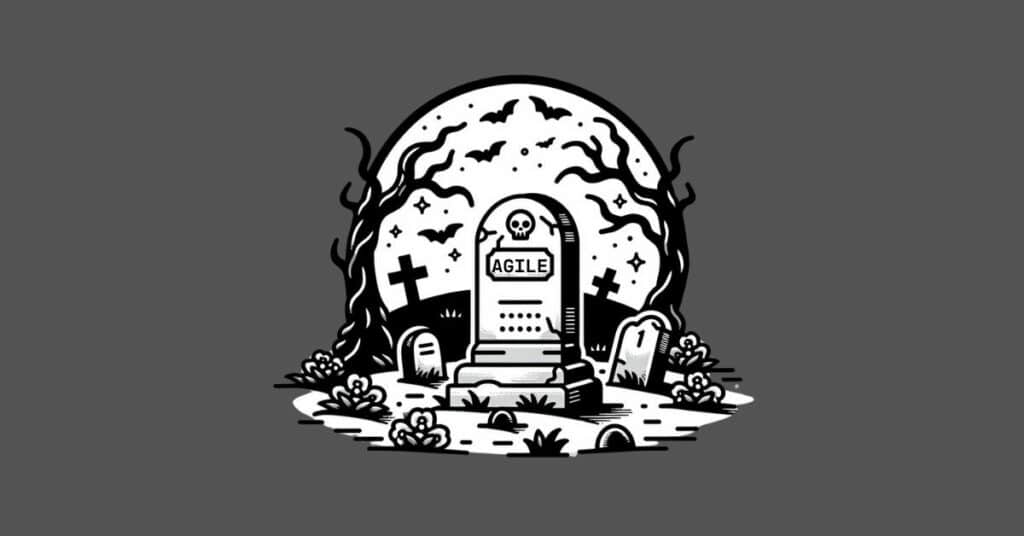If you’re part of a Scrum team, you know that the Daily Scrum is more than just a routine meeting; it’s the heartbeat of your project’s progress, a critical moment to align, adjust, and accelerate towards your Sprint goals. Yet, despite its importance, many teams find themselves grappling with common challenges that turn these meetings into a stumbling block rather than a steppingstone to success. That’s where our Daily Scrum Survival Kit comes into play.
We’ve crafted this downloadable toolkit with your needs in mind, packing it with essential resources designed to transform your Daily Scrums from mundane to monumental. From navigating through common pain points with our What-if Coaching Scenarios to leveraging our Sprint Burndown Excel Template for unmatched clarity on your progress, this kit is your all-in-one solution to mastering the art of effective Daily Scrums.
What’s in the Toolkit
Our Daily Scrum Survival Kit is designed with one goal in mind: to empower Scrum teams to conduct more efficient, productive, and engaging Daily Scrums. Here’s a closer look at what you’ll find inside this comprehensive toolkit:
Sprint Burndown Excel Template:

This dynamic template provides teams with a visual representation of their progress throughout the Sprint. It helps in tracking the amount of work completed against the planned work, offering a clear picture of where the team stands regarding their Sprint goals. It’s an invaluable tool for identifying potential delays early on and fostering a sense of urgency and accountability among team members.
Impediments Template:
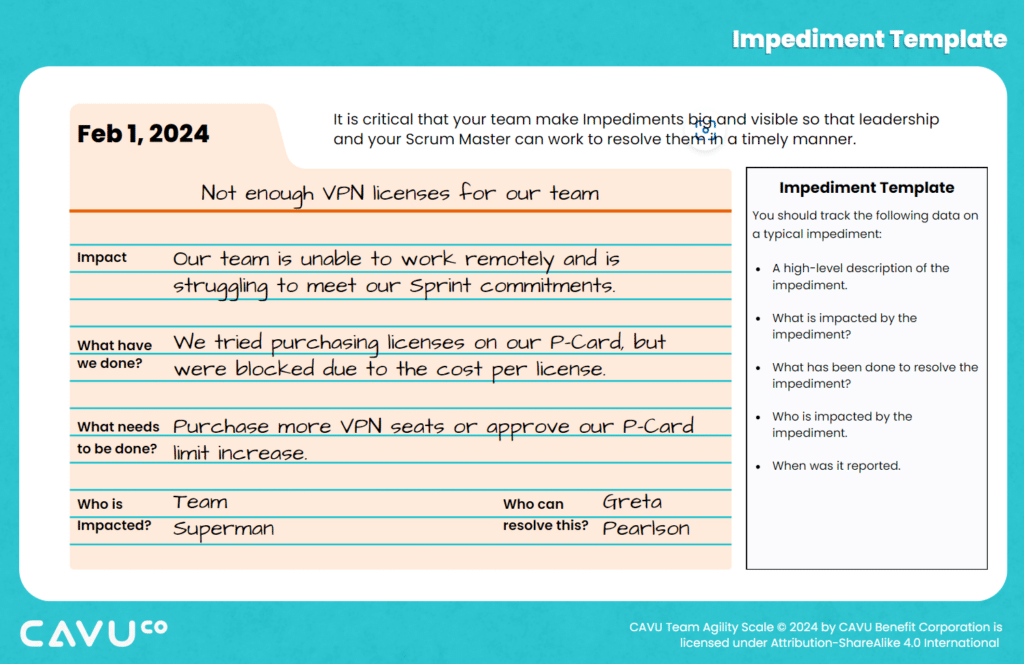
Encountering obstacles is a normal part of any project, but how you manage them can make or break your Sprint. Our Impediments Template is designed to help you document, track, and strategize around impediments, ensuring they are addressed promptly and effectively. This template encourages transparency and proactive problem-solving, turning challenges into opportunities for growth.
Daily Scrum Agenda:
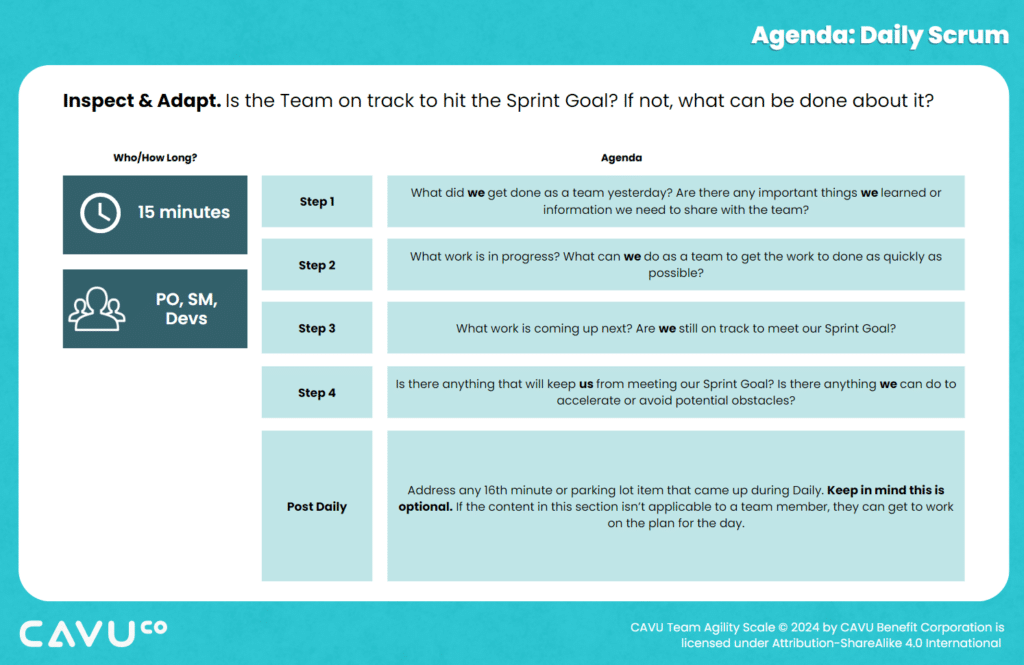
Keep your Daily Scrums focused and efficient with our structured agenda template. It outlines key points to cover in every meeting, ensuring that discussions remain on topic and time-boxed. This agenda serves as a guide to ensure that every team member is prepared, engaged, and contributing to the conversation.
What-if Coaching Scenarios:
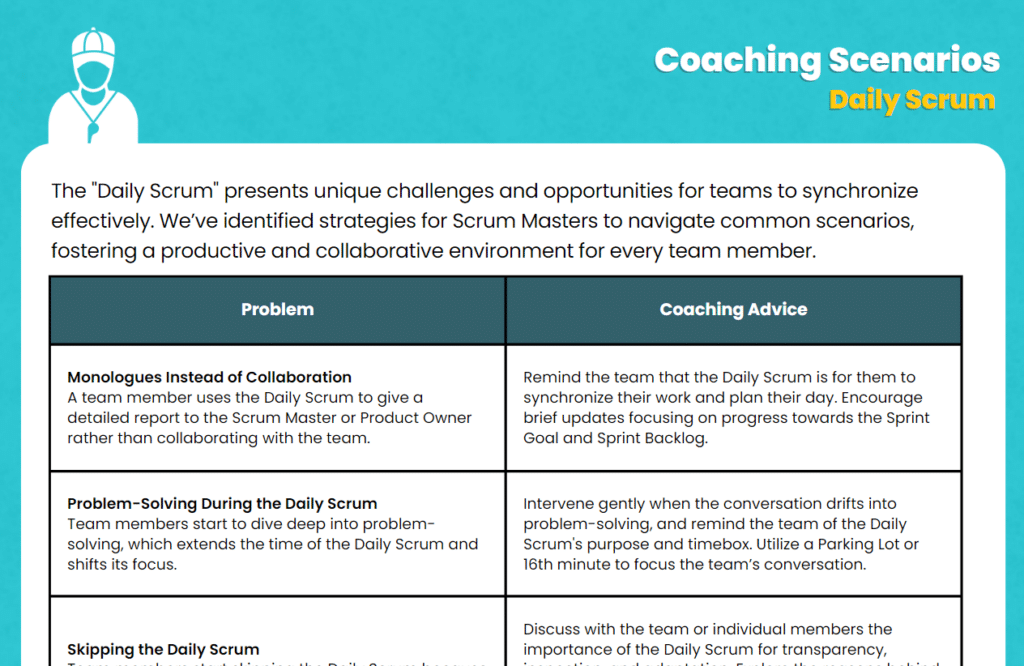
No two Daily Scrums are the same, and unexpected issues can arise. Our What-if Coaching Scenarios provide guidance on how to handle specific pain points that are common in daily meetings. From dealing with disengaged team members to managing scope creep, these scenarios offer practical advice and strategies to keep your Daily Scrum on track.
Daily Scrum Assessment Rubric:
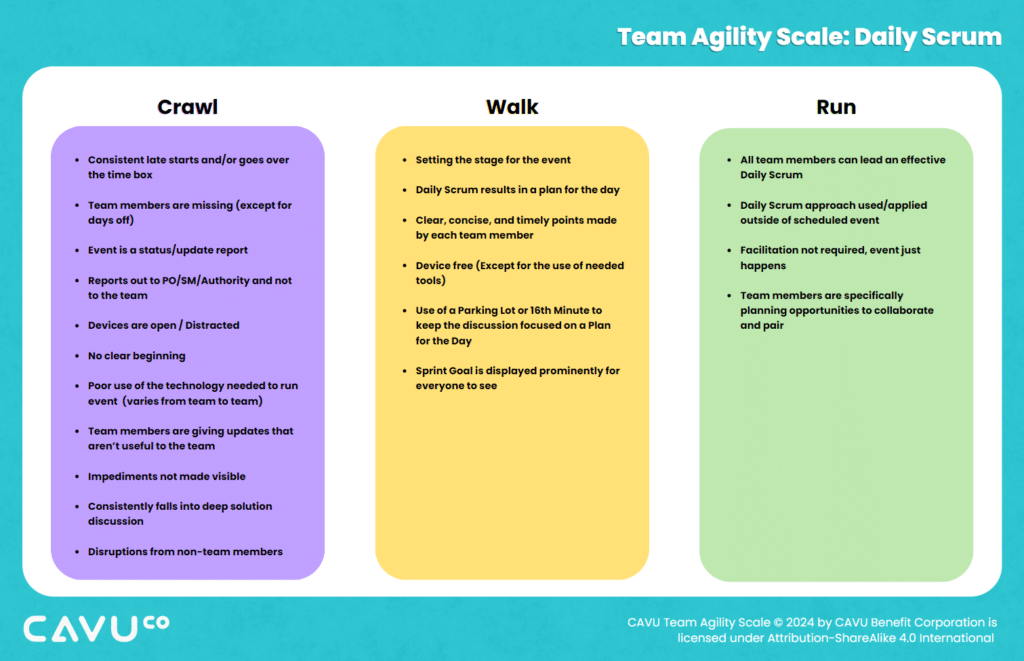
How do you know if your Daily Scrum is as productive as it could be? Our Assessment Rubric offers criteria to evaluate the effectiveness of your meetings. It helps teams identify areas of strength and opportunities for improvement, fostering continuous improvement in how they conduct their Daily Scrums.
Quick Sheet Summary of the Daily Scrum:
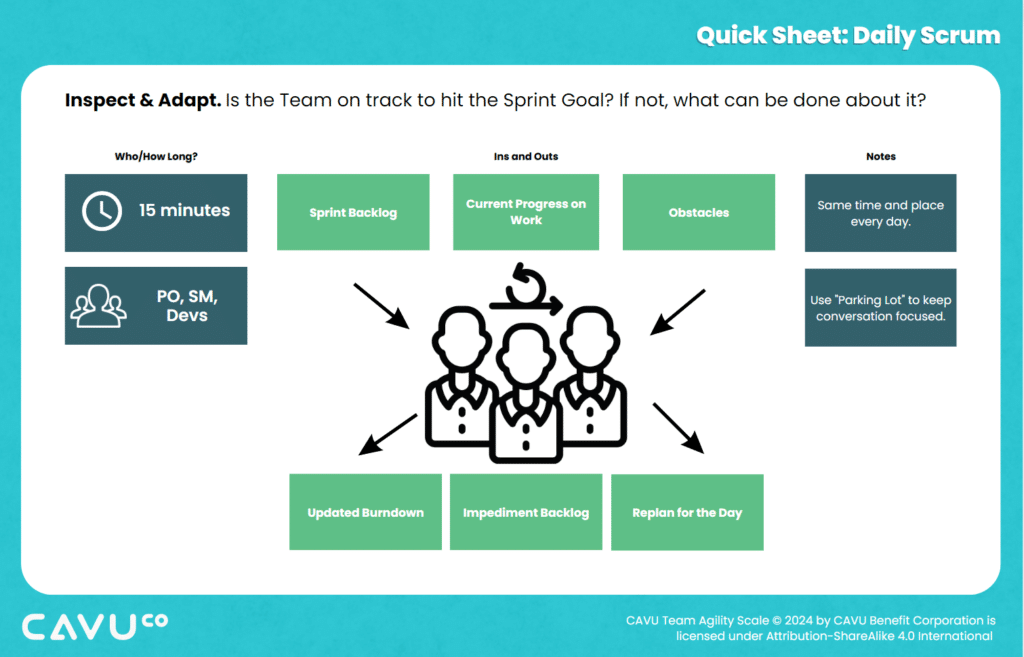
This handy reference provides a concise overview of the purpose, structure, and key components of an effective Daily Scrum. It’s perfect for quick consultations before meetings or for onboarding new team members, ensuring everyone understands the value and expectations of these daily check-ins.
How to Use the Sprint Burndown Template

The Sprint Burndown Chart allows teams to visualize their progress and adjust their trajectory towards the Sprint Goal. Here’s how to use the Sprint Burndown Excel Template included in our Daily Scrum Survival Kit:
Step 1: Setup Your Sprint Parameters

Begin by entering foundational details of your Sprint into the template:
- Team Name: Clearly identify the team responsible for the Sprint.
- Current Sprint Number: Indicate the Sprint cycle number.
- Sprint Length: Define the duration of the Sprint in days.
- Sprint Backlog Size: At the end of Sprint Planning, input the total size of your Sprint backlog, quantified in story points.
Step 2: Daily Tracking

At the end of each day, you’ll update four crucial columns in the template to reflect the day’s achievements and changes:
- Extra Value: Record any additional story points added to the backlog from work that was already in the backlog, known as Extra Value Story Points.
- Interrupts: Note the total story points added due to interrupts—these are unplanned tasks that were not in the backlog at the start of the Sprint.
- Removed: Deduct any story points for tasks that were taken out of the Sprint.
- Completed: Celebrate and document the total points for tasks moved to ‘Done’ that day.
Step 3: Burndown Chart Visualization

As you input the daily data, the template automatically updates the burndown chart. This chart features two lines:
- Ideal Line (Yellow): Represents the ideal burndown trajectory, assuming a consistent rate of completing story points throughout the Sprint.
- Actual Line (Blue): Reflects the actual story points completed each day, providing a real-time comparison against the ideal progress line.
Step 4: Analyzing and Adjusting
Utilize the burndown chart to analyze your team’s performance:
- Are you on track?: Compare the ‘Actual’ line with the ‘Ideal’ line to determine if you are ahead, on track, or behind your planned progress.
- Identify Patterns: Look for trends in Extra Value and Interrupts that may signal a need to adjust your Sprint Planning process or address frequent disruptions.
- Take Action: Use the insights from the burndown chart to discuss potential process improvements in your next Daily Scrum or Sprint Retrospective.
Step 5: Keep Your Team Informed
Share the updated burndown chart with your team regularly. Transparency ensures that every team member is aware of the Sprint’s status and can contribute to discussions on how to improve or maintain the momentum.
Maximizing Your Daily Scrum
The Daily Scrum is not just a meeting; it’s a strategic pivot point for your team’s success. When utilized effectively, this 15-minute huddle can sharpen your team’s focus, remove impediments, and propel you closer to your Sprint goals. Here’s how you can make the most out of your Daily Scrums:
- Cultivate Open Communication: The key to a successful Daily Scrum lies in fostering an environment where open communication is the norm. Encourage every team member to contribute, share updates, and highlight any obstacles they’re facing. This practice ensures that everyone is aligned and that issues are addressed promptly.
- Utilize Visual Tools: The Sprint Burndown Chart from our Daily Scrum Survival Kit offers a real-time visual cue of your progress. By updating this chart daily, your team can quickly see whether you are on track or if adjustments are needed to stay the course.
- Focus on the Sprint Goal: Every Daily Scrum should start with a reminder of the Sprint Goal. This keeps the team’s efforts directed towards the most critical outcomes and ensures that every task and discussion is relevant to achieving that goal.
- Stay Time-Boxed: Discipline is crucial. Keep your Daily Scrum within the 15-minute time box to maintain focus and efficiency. This constraint encourages brevity and relevance in discussions and ensures that the meeting doesn’t devolve into a time-consuming affair.
- Be Prepared: Preparation is half the battle won. Encourage team members to come to the meeting with updates on their tasks, ready to report on their progress since the last Daily Scrum, their plan for the day, and any impediments they need help with.
- Address Impediments Swiftly: Use our Impediments Template to capture and track any roadblocks identified during the Daily Scrum. The faster you can remove these impediments, the smoother your path to the Sprint finish line.
- Adapt and Improve: The Daily Scrum is an opportunity to adapt your Sprint plan based on the realities of your work. Use feedback from these meetings to iterate on your approach and continuously improve.
- Leverage the Agenda: Following a structured agenda ensures that the meeting stays on point. Our Daily Scrum Survival Kit includes an agenda template that can guide your team through an efficient and productive Daily Scrum.
- Engage the Entire Team: While the Developers are typically the focus of the Daily Scrum, it’s essential to involve the Scrum Master and Product Owner. Their presence can facilitate quick decision-making and provide immediate feedback, contributing to a cohesive team dynamic.
By implementing these strategies, your Daily Scrum will transform from a mundane check-in to a catalyst for significant strides in your team’s success.



















